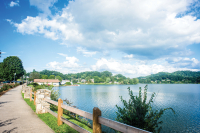The swamp a ghost saved
 Yay! Spring break! That special time to be sequestered with adolescents and/or pre-adolescents in about 50 square feet while hurtling down the highway at 70 m.p.h.
Yay! Spring break! That special time to be sequestered with adolescents and/or pre-adolescents in about 50 square feet while hurtling down the highway at 70 m.p.h.
“What?”
“Take the ear buds out.”
“What?”
“He said you have ear bugs.”
“I do not have ear bugs, and nobody asked you.”
Related Items
“Who needs to pee?”
“What?”
“He said move your knee.”
“Daddy, tell her to leave my knee alone.”
And so it goes, that wonderful non sequitur called family time.
School had a noon dismissal on the Friday preceding spring break. Our ultimate destination was Cumberland Island National Seashore, but we thought we would take advantage of the early dismissal and breakup the six to seven hour drive. We decided to drive just beyond Columbia, South Carolina, and take a short side trip to Congaree National Park. It was a wonderful decision.
Congaree is about 26,000 acres of bottomland hardwood floodplain adjacent to the Congaree and Wateree rivers. More than 11,000 acres of Congaree are classified as old growth – make that tall old growth. Sometimes characterized as the tallest bottomland hardwood forest on the planet, Congaree is home to 15 “tallest” species records — they include a 167-foot tall loblolly pine, 157-foot sweetgum, 154-foot cherrybark oak, 135-foot American elm, 133-foot chestnut oak, 131-foot overcup oak, a possum-dizzying 127-foot persimmon and a 125-foot laurel oak. The park is home to 81 species of trees.
We didn’t have time for an extended trek in the park, but that was OK because the wonder begins as soon as one walks into the forest. We did a loop, between two and three miles, starting and ending at the Harry Hampton Visitor Center. Part of the hike was on boardwalks through the swamp and part on a sandy/loamy trail through the woods. Hundred-foot tall loblolly pines were within a stone’s throw of the visitor center and before we knew it we were among large bald cypresses — their knees surrounding them like an army of minions — and big-buttressed tupelo gums were rising from the frequently flooded earth. My Loosiana soul was glowing, I was home. And if I needed any convincing, the cottonmouth we saw cruising up Weston Lake, riding high in the water, fat triangular head raised, tongue flicking, checking out it’s surroundings sealed the deal.
And Congaree was in line to follow the fate of the bottomland hardwoods of northeastern Louisiana where I grew up. The chainsaws were gassed and oiled, engines revving when, in 1971, a young lawyer, state representative and environmental activist (my how times have changed) named Alex Sanders invited other environmentalists, members of the media and an Audubon representative to meet him for a tour of Congaree. According to Dick McMichael, a news journalist working for WIS-TV in Columbia, in his book The Newsman:
“We came to a predetermined spot in the swamp and all outboard motors stopped and everyone was told to be real quiet. All of a sudden we heard the recording of the Ivory-billed Woodpecker crashing the silence. Then we heard all sorts of birdcalls coming back to us. Out of that symphony of swamp birds, the Audubon Society declared that he heard the vory-billed woodpecker answering back. I was in another boat shooting the event with a sixteen-millimeter Bolex movie camera. My audio recorder was running when the bird racket broke out. Alex, who could see the bird man’s face from his boat, said that tears rolled down his cheeks as he claimed he had heard the bird. After we got back to the boat dock, I interviewed the expert and Alex. Monday night the report ran. Timbering in the Santee Swamp stopped.”
Jack Hitt wrote a piece for the New York Times in May 2012, reflecting on ivory-billed woodpecker claims after the mysterious disappearance of any ivory-billed signs following the mysterious announcement by Cornell Lab of Ornithology that the ivory-bill had been rediscovered in Arkansas — in the piece, he said he asked Sanders abut the bird’s whereabouts and Sanders replied, “I don’t know where he is now, but I know where he was when we needed him.”
In a couple of weeks before returning to the Nantahala and Pisgah national forests, we will look at another unique forest type — the maritime forest of Cumberland Island National Seashore.
(Don Hendershot is a writer and naturalist. He can be reached a This email address is being protected from spambots. You need JavaScript enabled to view it..)









